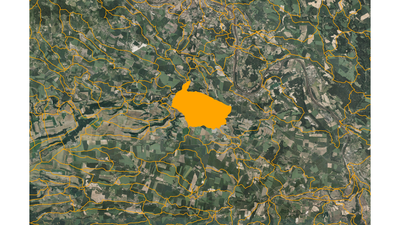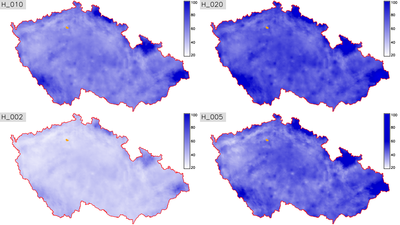Note: This document is for an older version of GRASS GIS that has been discontinued. You should upgrade, and read the current manual page.

NAME
r.subdayprecip.design - Computes subday design precipitation totals.KEYWORDS
raster, hydrology, precipitationSYNOPSIS
Flags:
- --help
- Print usage summary
- --verbose
- Verbose module output
- --quiet
- Quiet module output
- --ui
- Force launching GUI dialog
Parameters:
- map=name [required]
- Vector map of location under analysis
- Or data source for direct OGR access
- return_period=name[,name,...] [required]
- Rainfall raster maps of required return period
- rainlength=integer [required]
- Design rainfall length in minutes
- Options: 0-1439
- area_size=float
- Maximum area size to be processed (in km2, -1 for no limit)
- Default: 20
Table of contents
DESCRIPTION
r.subdayprecip.design computes subday design precipitation totals based on Hradek's method of reduction of daily maximums to chosen duration.The tool uses methods of zonal statistics to compute average values of 24 hours precipitation amounts of specified return period for a provided area or a spot. Rasters of daily maxima were derived from statistics published by Samaj et al. in 1985, which were based on precipitation series observed in 1901-1980. Calculated average value (in millimeters) is then reduced to the chosen length of design rain event.
NOTES
Subday design precipitation series are important for hydrological modelling and soil erosion problems in a small catchment scale when designing common measures for promoting water retention, landscape drainage systems, flood mitigation measures etc.First automatization has been implemented by well-known method which is based on reduction of 24 hours design precipitation to shorter time. GIS can used for spatial supervised classification of point values of specified return periods (2, 10, 20, 50 and 100 years).
 |
 |
| Figure: Basins (in orange) with orthophoto on background |
Figure: Return periods (2, 10, 20, 50 years) in the area of the Czech Republic |

Figure: IV.order basins colored by mean H_N2T60 value (in millimeters)
EXAMPLE
r.subdayprecip.design map=basin return_period=N2,N5,N10,N20 rainlength=60
REFERENCES
- Landa M., Kavka P., Strouhal L. (2015). A GIS tool for reduction day precipitation to subday (poster)
- Tomasu M. (2013). Tvorba nastoje pro sestaveni kratkodobych navrhovych destu na zaklade rizene interpolace a redukce (in Czech)
- Torfs, P. J. J. F., Horacek, S., & Rakovec, O. (2010). Chimera, a framework for conceptual modelling using analytical sensitives to parameters: implementation and application to PDM model.
- Sokol, Z., & Bliznak, V. (2009). Areal distribution and precipitation-altitude relationship of heavy short-term precipitation in the Czech Republic in the warm part of the year. Atmospheric Research, 94(4), 652-662.
Acknowledgement
This work has been supported by the research project QJ1520265 - "Variability of Short-term Precipitation and Runoff in Small Czech Drainage Basins and its Influence on Water Resources Management".SEE ALSO
v.rast.stats, v.what.rastAUTHOR
Martin Landa, GeoForAll (OSGeoREL) Lab, Czech Technical University in Prague, Czech RepublicThe module is inspired by Python script developed for Esri ArcGIS platform by M. Tomasu in 2013.
SOURCE CODE
Available at: r.subdayprecip.design source code (history)
Latest change: Friday Feb 21 23:33:10 2025 in commit: 7c352906eece252043d8b84aefcbe49c88f22275
Main index | Raster index | Topics index | Keywords index | Graphical index | Full index
© 2003-2024 GRASS Development Team, GRASS GIS 8.3.3dev Reference Manual